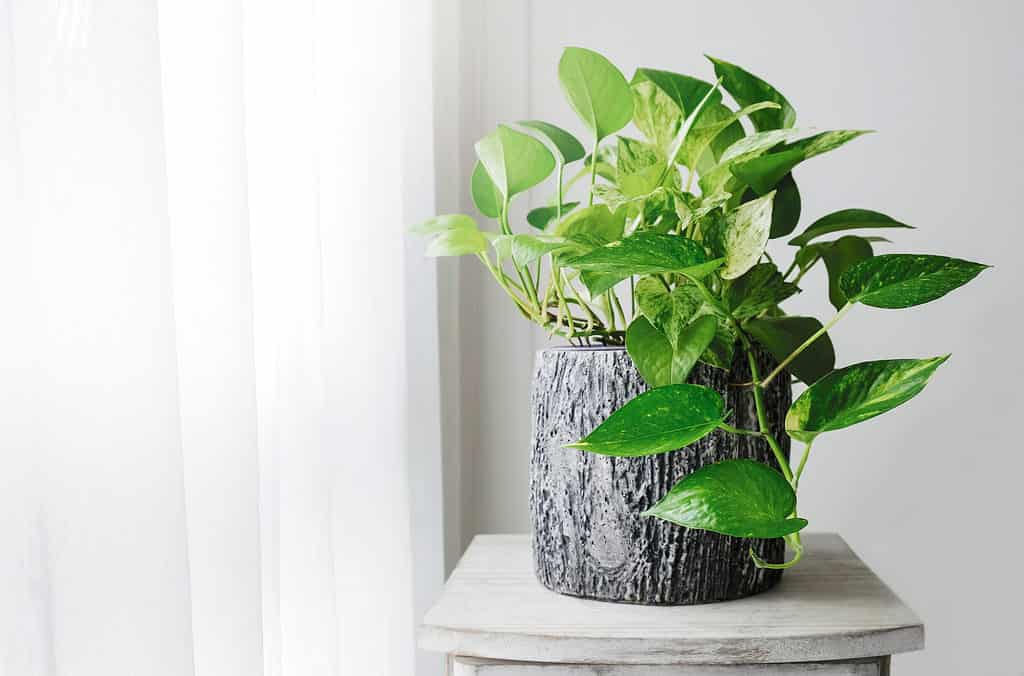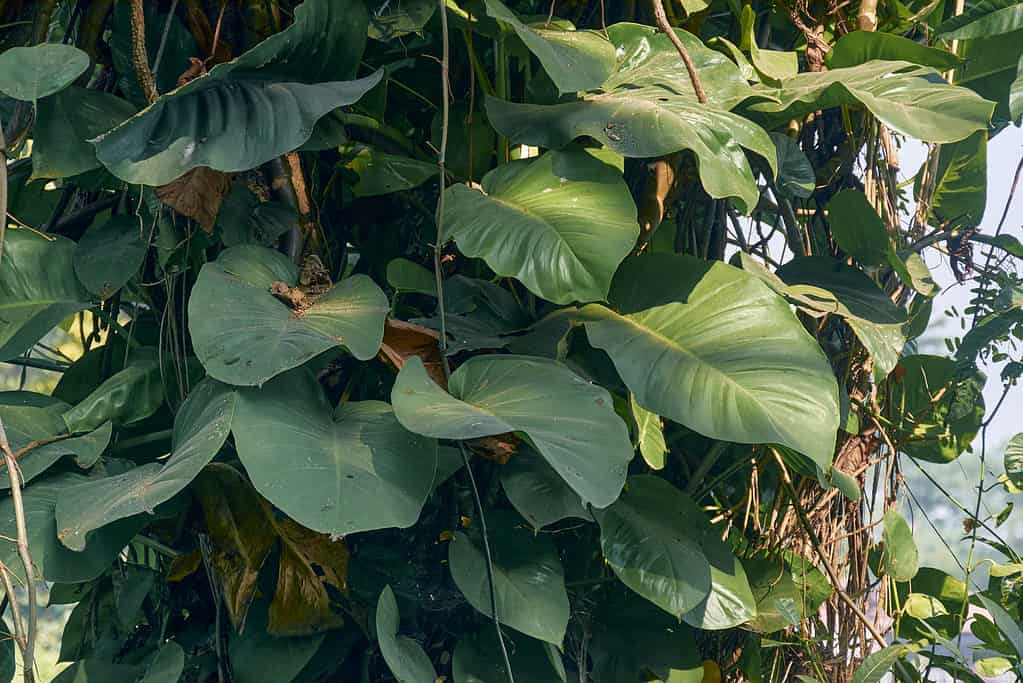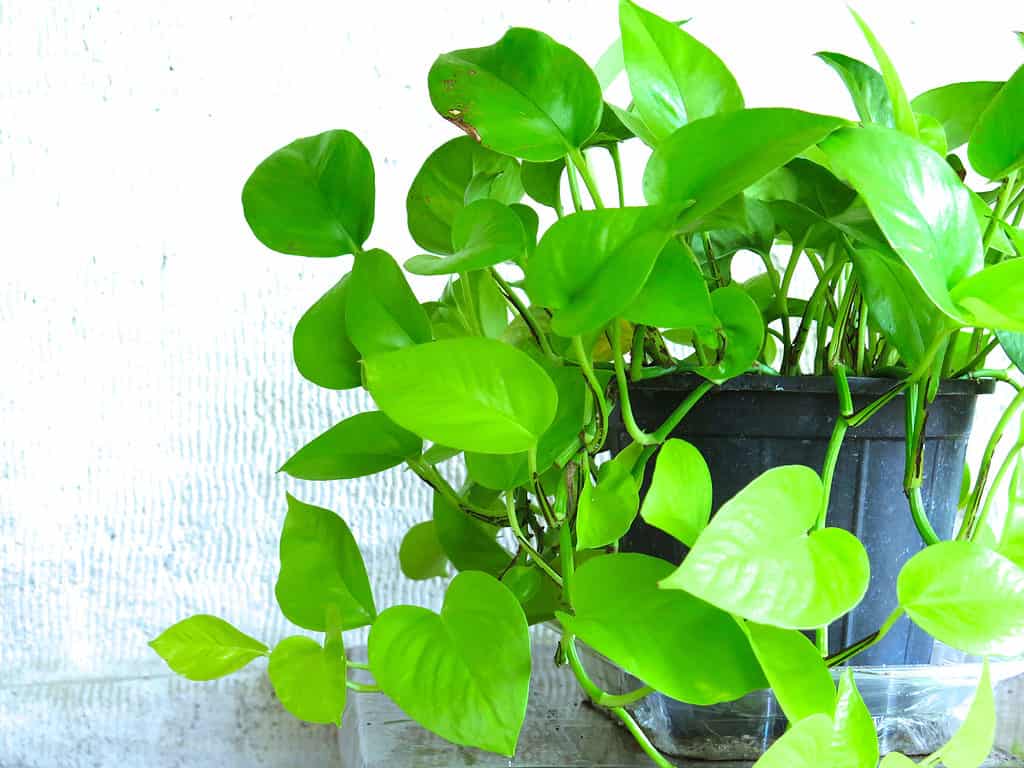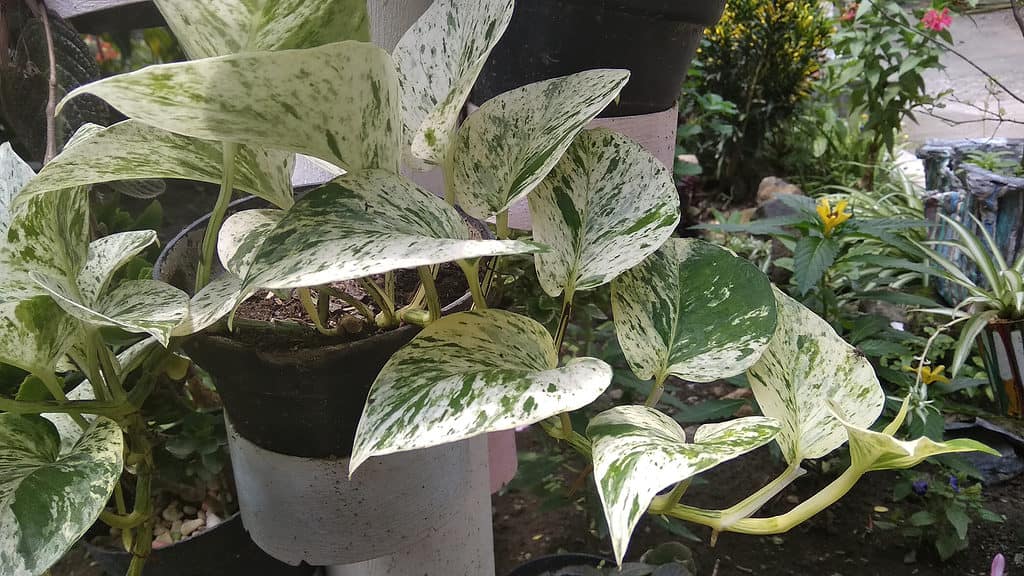If you’re looking for a beginner-friendly, highly resilient houseplant, then look no further than devil’s ivy, aka pothos. So named for its almost unkillable nature, this lovely vine is currently one of the most popular houseplants and is available in over a dozen cultivars.
In this guide, we’ll discuss how to care for this tolerant houseplant and what its basic light, temperature, soil, humidity, and watering requirements are.
So, without further ado, let’s jump in!

Pothos, commonly called devil’s ivy, is a widely popular houseplant due to its almost unkillable nature.
©ArtBackground/Shutterstock.com
Why Pothos is Called Devil’s Ivy
Pothos, Epipremnum aureum, is a tropical perennial vine native to the Solomon Islands of the South Pacific. In the wild, this robust climbing vine can grow up to 65 feet long with enormous leaves that can grow up to 3 feet long and wide. As a houseplant, pothos remains in its juvenile phase, where it lives up to 10 years and typically reaches up to 10 feet long with a 3-foot spread.
Famous for its resilience, one of Epipremnum aureum’s common names is devil’s ivy. This is a nod to this plant’s low-maintenance care requirements and high resistance to disease that give pothos its “unkillable” status. Of course, calling this plant “unkillable” is hyperbolic and meant to emphasize the resilient nature and beginner-friendly growing requirements of pothos.
Additionally, devil’s ivy does not actually belong to the ivy genus like poison ivy, although it is a climbing vine. While Epipremnum aureum belongs to the Aracea family, ivy species belong to the Araliaceae family.
For devil’s ivy plant care, you’ll still need to meet its basic growing requirements, and below, we’ll go into detail about these growing conditions.

In the wild
Epipremnum aureum(devil’s ivy) can grow up to 65 feet long with enormous leaves up to 3 feet long and wide.
©iStock.com/Suprabhat Dutta
Light Requirements
One of the reasons devil’s ivy makes an excellent houseplant is that it doesn’t require direct sunlight. Rather, this plant needs a medium to bright, indirect sunlight. This light requirement stems from its growing habit as a vine in ecosystems where it grows under dense, tropical canopies. Generally, Epipremnum aureum and its many cultivars grow happily in medium indirect light. However, some cultivars, like ‘Neon’ pothos, will lose their vibrant yellow-green leaves unless grown in bright indirect light.

The pothos cultivar
Epipremnum aureum‘
Neon‘ will lose its vibrant yellow-green leaves unless grown in bright indirect light.
©M.Sabouri/Shutterstock.com
Devil’s Ivy Plant Care: Temperature Requirements
As a tropical plant, devil’s ivy thrives in warm temperatures. It likes temperatures between 70-90 degrees Fahrenheit, although it will generally do fine to 55 degrees Fahrenheit. Below that, you’ll likely see this tropical vine start to struggle. Remember, there’s quite a difference between a plant tolerating conditions and thriving in them. If you want your pothos to thrive, definitely aim to keep them in temperatures above 70 degrees Fahrenheit, especially in its growing season. In the Winter, when the plant goes dormant, it can tolerate lower temperatures better.
Soil Requirements
Regarding their soil requirements, pothos is tolerant of a range of soils as long as the soil is well-draining with air pockets. Pretty much any indoor potting mixture will work just fine for pothos. This plant does have a preference for slightly acidic soil (6.0-6.5 pH), but most houseplant potting/soil mixes fit this condition as well. If your mix doesn’t already contain it, you can add in a few handfuls of perlite or coco coir, which improves the growing medium’s ability to drain.
The major soil type pothos does not tolerate is compacted soil that doesn’t drain well. So if you scooped up clay-based soil and tried to grow devil’s ivy in that medium, it likely would either not survive or not thrive.
Devil’s Ivy Plant Care: Humidity Requirements
As a plant native to the tropics, devil’s ivy plant care involves providing a suitable amount of humidity. Ideally, you’ll want to provide this plant with a humidity range of 50-70%. Now, pothos can certainly tolerate lower humidity levels. But you’re less likely to see impressive vine growth and foliage display at lower humidity.
Most indoor environments controlled with central air and heating stay between 35-55% air humidity. You may thus want to place a small humidifier near your plants. Cultivars with white variegation, such as ‘Marble Queen,’ may suffer crispy leaves if humidity is below 50%. So you’ll definitely want to make sure you provide enough humidity for those cultivars.

‘Marble Queen’ (Marble queen pothos) may suffer crispy leaves at humidity levels below 50%.
©Rezqiano/Shutterstock.com
Watering Requirements
The watering requirements for pothos can vary slightly based on the cultivar. But generally, devil’s ivy is somewhat drought tolerant and doesn’t have notably strict watering needs. Essentially, Epipremnum aureum and its cultivars are quite happy with weekly waterings. You should be able to tell when your pothos needs to be watered by testing the dryness of the soil. For most cultivars, they’ll need watering when the top 2-3 inches of the soil is completely dry. You can test this with your finger or by using a soil moisture meter.
The photo featured at the top of this post is © iStock.com/Jenny Sun
Sources
- Wisconsin Horticulture, Available here: https://hort.extension.wisc.edu/articles/pothos-epipremmum-aureum/
- Almanac, Available here: https://www.almanac.com/plant/pothos
- Missouri Botanical Garden, Available here: https://www.missouribotanicalgarden.org/PlantFinder/PlantFinderDetails.aspx?taxonid=276360
Thank you for reading! Have some feedback for us? Contact the AZ Animals editorial team.






